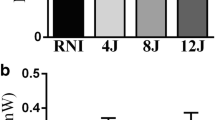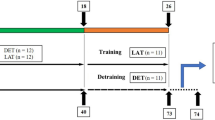Abstract
The aim of the present study was to determine whether low-level laser therapy (LLLT), when used in conjunction with aerobic training, interferes with the expression of inflammatory markers IL-6 and TNF-α, thereby influencing the performance of old rats participating in swimming. A total of 30 Wistar rats (Rattus norvegicus albinus) were used for this study: 24 aged rats, and 6 young rats. The older animals were randomly divided into four groups designated as follows: aged-control, aged-exercise, aged-LLLT, aged-LLLT/exercise group, and young-control animals. Aerobic capacity (VO2max) was analyzed before and after training period. The aged-exercise and aged-LLLT/exercise groups were trained for 6 weeks. LLLT laser was applied before each training session with 808 nm and 4 J of energy to the indicated groups throughout training. The rats were euthanized, and muscle tissue and serum were collected for muscle cross-sectional area and IL-6 and TNF-α protein analysis. In VO2 showed statistical difference between young- and aged-control groups (used as baseline) (p < 0.05). The same difference can be observed in the young control group compared with all intervention groups (exercise, LLLT and LLLT + exercise). In comparison with the aged-control group, a difference was observed only for comparison with the exercise group (p < 0.05), and exercise associated with LLLT group (p < 0.001). Levels of IL-6 and TNF-α for the aged-exercise and the aged-LLLT/exercise groups were significantly decreased compared to the aged-control group (p < 0.05). Analysis of the transverse section of the gastrocnemius muscle showed a significant difference between the aged-exercise and aged-LLLT/exercise groups (p < 0.001). These results suggest that laser therapy in conjunction with aerobic training may provide a therapeutic approach for reducing the inflammatory markers (IL-6 and TNF-α), however, LLLT without exercise was not able to improve physical performance of aged rats.




Similar content being viewed by others
References
Santos RV, Viana VA, Boscolo RA et al (2012) Moderate exercise training modulates cytokine profile and sleep in aged people. Cytokine 60(3):731–735
Huey KA, Hilliard CA, Hunt CR (2013) Effect of HSP25 loss on muscle contractile function and running wheel activity in young and old mice. Front Physiol 4:398
Milanović Z, Pantelić S, Trajković N, Sporiš G, Kostić R, James N (2013) Age-related decrease in physical activity and functional fitness among elderly men and women. Clin Interv Aging 8:549–556
Franceschi C, Bonafè M, Valensin S et al (2000) Inflamm-aging. An evolutionary perspective on immunosenescence. Ann N Y Acad Sci 908:244–254
Chung HY, Cesari M, Anton S et al (2009) Molecular inflammation: underpinnings of aging and age-related diseases. Ageing Res Rev 8(1):18–30
Waters DL, Baumgartner RN, Garry PJ, Vellas B (2010) Advantages of dietary, exercise-related, and therapeutic interventions to prevent and treat sarcopenia in adult patients: an update. Clin Interv Aging 7(5):259–270
Visser M, Pahor M, Taaffe DR et al (2002) Harris Relationship of interleukin-6 and tumor necrosis factor-alpha with muscle mass and muscle strength in elderly men and women: the Health ABC Study. J Gerontol A Biol Sci Med Sci 57:M326–M332
Pedersen M, Bruunsgaard H, Weis N et al (2003) Circulating levels of TNF-alpha and IL-6-relation to truncal fat mass and muscle mass in healthy elderly individuals and in patients with type-2 diabetes. Mech Ageing Dev 124:495–502
Colbert LH, Visser M, Simonsick EM et al (2004) Physical activity, exercise, and inflammatory markers in older adults: findings from the Health, aging and body composition study. J Am Geriatr Soc 52(7):1098–1104
Souza NH, Marcondes PT, Albertini R, Mesquita-Ferrari RA, Fernandes KP, Aimbire F (2013) Low-level laser therapy suppresses the oxidative stress-induced glucocorticoids resistance in U937 cells: relevance to cytokine secretion and histone deacetylase in alveolar macrophages. J Photochem Photobiol B 130C:327–336
Alves AC, Vieira R, Leal-Junior E et al (2013) Effect of low-level laser therapy on the expression of inflammatory mediators and on neutrophils and macrophages in acute joint inflammation. Arthritis Res Ther 15(5):R116
Laraia EM, Silva IS, Pereira DM et al (2012) Effect of low-level laser therapy (660 nm) on acute inflammation induced by tenotomy of Achilles tendon in rats. Photochem Photobiol 88(6):1546–1550
De Marchi T, Leal Junior EC, Bortoli C, Tomazoni SS, Lopes-Martins RA, Salvador M (2012) Low-level laser therapy (LLLT) in human progressive-intensity running: effects on exercise performance, skeletal muscle status, and oxidative stress. Lasers Med Sci 27(1):231–236
Sussai DA, Carvalho Pde T, Dourado DM, Belchior AC, dos Reis FA, Pereira DM (2010) Low-level laser therapy attenuates creatine kinase levels and apoptosis during forced swimming in rats. Lasers Med Sci 25(1):115–120
Baroni BM, Leal Junior EC, De Marchi T, Lopes AL, Salvador M, Vaz MA (2010) Low-level laser therapy before eccentric exercise reduces muscle damage markers in humans. Eur J Appl Physiol 110(4):789–796
Leal Junior EC, Lopes-Martins RA, Frigo L et al (2010) Effects of low-level laser therapy (LLLT) in the development of exercise-induced skeletal muscle fatigue and changes in biochemical markers related to postexercise recovery. J Orthop Sports Phys Ther 40(8):524–532
Leal Junior EC, Lopes-Martins RA, Dalan F et al (2008) Effect of 655-nm low-level laser therapy on exercise-induced skeletal muscle fatigue in humans. Photomed Laser Surg 26(5):419–424
Leal-Junior EC, Vanin AA, Miranda EF et al (2013) Effect of phototherapy (low-level laser therapy and light-emitting diode therapy) on exercise performance and markers of exercise recovery: a systematic review with meta-analysis. Lasers Med Sci
Lopes-Martins RA, Marcos RL, Leonardo PS et al (2006) Effect of low-level laser (Ga-Al-As 655 nm) on skeletal muscle fatigue induced by electrical stimulation in rats. J Appl Physiol 101(1):283–288
Cechella JL, Leite MR, Dobrachinski F et al (2014) Moderate swimming exercise and caffeine supplementation reduce the levels of inflammatory cytokines without causing oxidative stress in tissues of middle-aged rats. Amino Acids 46(5):1187–1195
Leal Junior EC, Lopes-Martins RA, de Almeida P, Ramos L, Iversen VV, Bjordal JM (2010) Effect of low-level laser therapy (GaAs 904 nm) in skeletal muscle fatigue and biochemical markers of muscle damage in rats. Eur J Appl Physiol 108(6):1083–1088
Liu XG, Zhou YJ, Liu TC, Yuan JQ (2009) Effects of low-level laser irradiation on rat skeletal muscle injury after eccentric exercise. Photomed Laser Surg 27(6):863–869
Patrocinio T, Sardim AC, Assis L, Fernandes KR, Rodrigues N, Renno AC (2013) Effect of low-level laser therapy (808 nm) in skeletal muscle after resistance exercise training in rats. Photomed Laser Surg 31(10):492–498
Ferraresi C, Panepucci R, Reiff R, Júnior E, Bagnato V, Parizotto N (2012) Molecular effects of low-level laser therapy (808 nm) on human muscle performance. Phys Ther Sport 13(3):e5
Ferraresi C, Hamblin MR, Parizotto NA (2012) Low-level laser (light) therapy (LLLT) on muscle tissue: performance, fatigue and repair benefited by the power of light. Photon Lasers Med 1(4):267–286
Sarcopenia DM (2011) Pathophysiology and clinical relevance. Wien Med Wochenschr 161(17–18):402–408
Acknowledgments
This work was supported by grant number 2009/54225-8 from the São Paulo Research Foundation (FAPESP).
Conflicts of interest
Professor Ernesto Cesar Pinto Leal-Junior receives research support from Multi Radiance Medical (Solon, OH, USA), a laser device manufacturer. The remaining authors declare that they have no conflict of interests.
Author information
Authors and Affiliations
Corresponding author
Rights and permissions
About this article
Cite this article
Amadio, E.M., Serra, A.J., Guaraldo, S.A. et al. The action of pre-exercise low-level laser therapy (LLLT) on the expression of IL-6 and TNF-α proteins and on the functional fitness of elderly rats subjected to aerobic training. Lasers Med Sci 30, 1127–1134 (2015). https://doi.org/10.1007/s10103-015-1713-x
Received:
Accepted:
Published:
Issue Date:
DOI: https://doi.org/10.1007/s10103-015-1713-x




